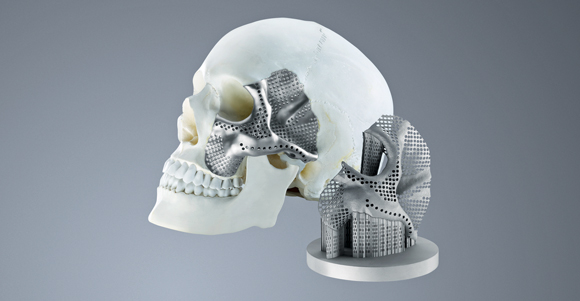Russia’s Conmet employs Trumpf technology for the production of custom craniomaxillofacial implants
December 12, 2018

Conmet uses Trumpf’s TruPrint 1000 AM system to produce customised craniomaxillofacial implants (Courtesy Trumpf)
In the conventional manufacturing of craniomaxillofacial implants, the surgeon must cut the implant out of a perforated titanium plate during an operation, while the patient is under anaesthetic, and then shape it to size in the operating room. This can lead to time pressure and added stress for the surgeon, potentially leading to variations in the quality of fit.
The production of personalised patient implants prior to surgery using metal Additive Manufacturing has been one of the most successful applications for the technology to date. One user of metal Additive Manufacturing in the production of patient implants is Conmet, a market leader in the field of craniomaxillofacial surgery and implantology based in Moscow, Russia.
The company is currently using TruPrint 1000 AM systems produced by Trumpf, Ditzingen, Germany, to manufacture implant components for markets in the Commonwealth of Independent States (CIS) and will soon be supplying elsewhere in Europe.
Conmet first began investigating Additive Manufacturing for the production of implants around a decade ago. At the time, however, the technology was still insufficiently mature for such applications. Andreas Margolf, Project Manager for Additive Manufacturing at Trumpf, commented, “Conmet asked various machine-tool suppliers to produce benchmark parts but wasn’t happy with the quality.”
In 2017, following a wide range of significant developments in Additive Manufacturing technology over the past decade, the company made the decision to reinvestigate the technology and approached Trumpf to find out how far it had evolved. “We set up a second meeting in Ditzingen,” Margolf continued. “Over the course of two days, our experts answered all their questions on Additive Manufacturing, while our machines produced the benchmark parts.”
This time, Conmet was sufficiently impressed by the quality of parts and the design of the system, all of which met its requirements. “Trumpf is the only supplier on the market for 3D printing that develops its own lasers and all the optical components,” Margolf added. “Trumpf also has a wealth of experience in the areas of machine tools and services. That means we’re able to assist Conmet with any aspect of the process.”
The right machine with the right process parameters
The first task for Trumpf’s team was to determine the right machine for Conmet, along with the relevant process parameters for the production of medical implants. According to Trumpf, it soon became clear that the ideal setup was Trumpf’s own TruPrint 1000 AM system. This machine is especially compact and could therefore be comfortably installed in Conmet’s existing production facilities. Equipped with a 200 W fibre laser developed in-house by TRUMPF, the machine is also highly suitable for use with the titanium alloys generally used to produce medical implants.
Trumpf also assisted Conmet in fine-tuning the focal diameter at which the laser beam hits the powder bed. “Our tests showed that reducing the focal diameter to 30 µm improves the surface smoothness of the implants by around 20%,” Margolf explained. “This makes the process slower and slightly more expensive, but reduces the cost of post-processing the surface.”
A 40% reduction in production costs
Conmet has now been operating with the TruPrint 1000 at its Moscow production facilities since the beginning of 2018, for the production of dental components and craniomaxillofacial implants, for example for cancer patients. These products are marketed in the CIS region and in Europe.
To manufacture the implants, hospitals provide Conmet with the CT data of the patients who require them; the company’s engineers then design the implant in consultation with the surgeon before additively manufacturing it on the TruPrint 1000. “We currently produce sixty implants a month with the TruPrint 1000, and we’re planning to increase our output by 10%,” stated Nadeschda Morozova, Project Manager at Conmet.
The implants produced are said to be of an especially high quality overall, as well as being substantially cheaper than conventionally manufactured implants. “Compared to conventional machining methods such as turning and milling, the new process saves us 40% in production costs,” Morozova reported.
In the near future, the company stated that it intends to begin production of custom-fit spinal fixation devices using AM. The company also has plans to manufacture mass-produced prosthetics with the TruPrint 1000. For this, it will once again opt for Trumpf technology with a TruPrint 3000, which features a larger build chamber.
Medical devices produced by Conmet are certified according to European standards, signifying a high degree of reliability and repeatability. Since Trumpf supplies not only the AM machine but also the associated products, including substrate plate, software and process parameters, it was stated that the implants produced are highly congruent.
In addition, Trumpf Moscow provides a local service partner and Russian-speaking technicians to support Conmet wherever necessary. “It’s not just about the customer buying equipment from us; we also want to see them earn money,” Margolf concluded. “Conmet’s success with Additive Manufacturing shows we’re on the right track!”
With a staff of about 13,400, Trumpf generated sales of nearly €3.6 billion for the 2017/18 fiscal year. The company has a development ratio of over 9% and remains an independent, family-owned business, which is represented by over seventy global subsidiaries in Germany, France, the UK, Italy, Austria, Switzerland, Poland, the Czech Republic, the USA, Mexico, China and Japan.
















